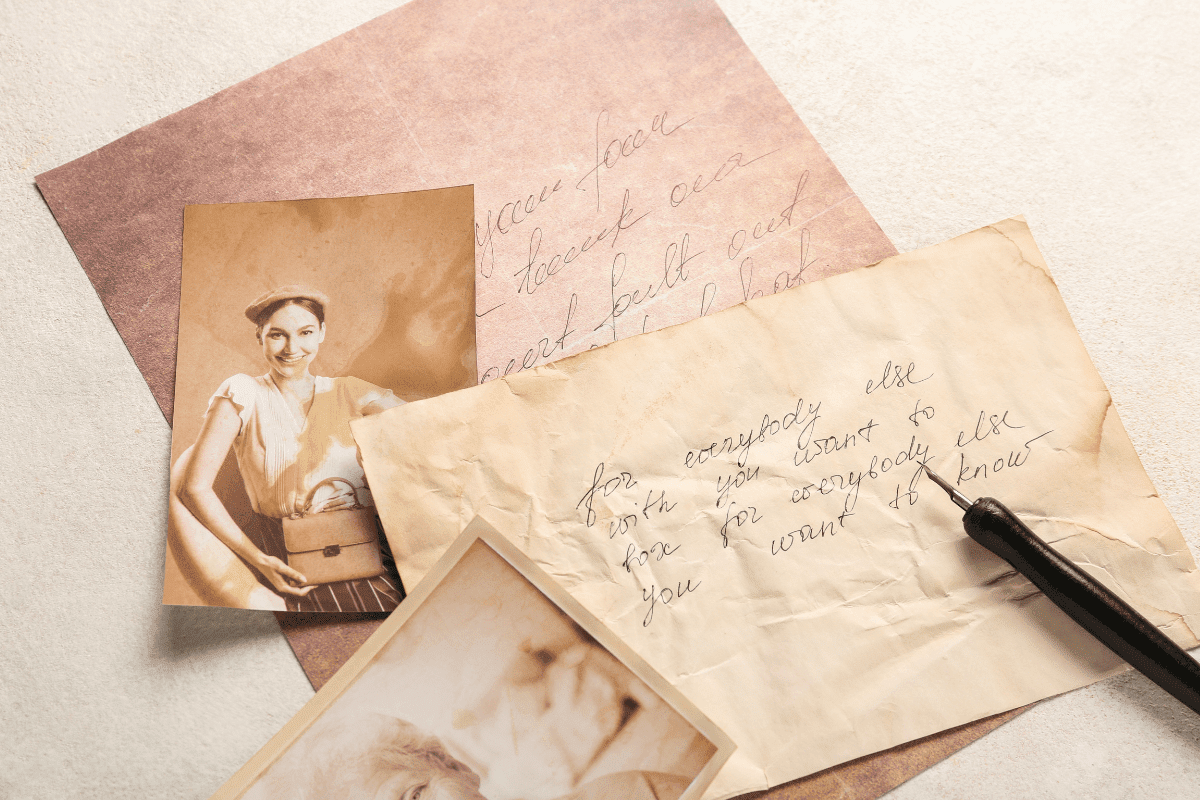Ever wondered if you're related to royalty, or maybe just curious about why your great-aunt Mildred always insisted the family came from "somewhere fancy"? Tracing your family history can feel overwhelming at first, like trying to solve a puzzle where half the pieces are missing and the other half are scattered across different continents. But here's the good news: with the right approach and some patience, you can uncover fascinating stories about your ancestors without breaking the bank or needing a PhD in genealogy.
Start with what you know
Before you dive into fancy databases or start pestering distant relatives, take a good look around your own house. You'd be amazed at the treasure trove of family information that's probably sitting right under your nose, disguised as everyday items.
That shoebox of old photos your mom keeps threatening to organize? Pure genealogical gold. Those random papers stuffed in kitchen drawers? Potential jackpots. Even that ancient family Bible that nobody reads anymore often contains handwritten family records on the front pages that are worth their weight in genealogical currency.
Document everything you already have
Start by gathering every scrap of family-related paperwork you can find. This isn't just about the obviously important stuff like birth certificates and marriage licenses. Check the backs of old photographs for handwritten notes about dates and names. Dig through greeting cards, holiday decorations, and yes, even those participation trophies from little league might have dates that help establish where your family was living during specific years.
Military discharge papers and immigration documents are absolute gems if you can find them. Old passports, high school yearbooks, and employment records might seem mundane, but they provide crucial clues about where your relatives lived and worked during specific time periods. Wedding invitations and funeral programs often contain information about family relationships that you won't find anywhere else.
Here's what to look for in your family document hunt:
- Handwritten notes on photo backs
- Family Bible records
- Military discharge papers
- Immigration documents and old passports
- High school yearbooks
Create a simple family tree
Once you've gathered your initial documents, create a basic family tree starting with yourself and working backward. Don't worry about making it perfect or fancy at this stage. A simple handwritten chart or basic computer document works fine. Record everything you know: full names, birth and death dates, marriage information, places of residence, and occupations.
The key here is to work chronologically backward through the generations. Start with your parents, then your grandparents, then your great-grandparents. This systematic approach helps you build a solid foundation and makes it easier to spot gaps where you need more information.
Interview family members
Your older relatives are walking encyclopedias of family history, and unfortunately, they won't be around forever. This is probably the most time-sensitive part of your genealogy research, so don't put it off until "someday when you have more time."
The trick to successful family interviews isn't just asking "tell me about our family history" and hoping for the best. You need to be a bit more strategic than that, while still keeping things conversational and relaxed.
Preparation and approach
Before you start interrogating Uncle Bob about his childhood memories, do a little homework. Review what you already know and prepare specific questions that might trigger detailed memories. Instead of asking "What do you remember about Grandma?" try "What do you remember about Grandma's cooking?" or "Where did the family usually gather for holidays?"
Always ask permission before recording conversations. Some people freeze up when they see a recording device, while others are more comfortable when they know their stories are being preserved. If recording makes someone uncomfortable, take detailed notes instead. The most important thing is that they feel relaxed enough to share their memories.
Pay attention to family legends and stories that might seem a bit embellished. Sure, your great-uncle probably didn't actually fight alongside famous historical figures, but these tales often contain kernels of truth about military service, immigration experiences, or family occupations that can guide your research in the right direction.
Documentation and follow-up
After each interview, send a thank-you note and share any interesting discoveries you make based on their information. This approach often encourages relatives to remember additional details or dig through their own collections of family documents. You'd be surprised how often someone will call you a week later saying, "Oh, I just remembered something else about Aunt Sally."
Keep detailed notes about who told you what and when. Family stories can sometimes conflict with each other or with official records, and knowing the source helps you evaluate the reliability of different pieces of information.
Free resources for beginning genealogists
Here's where things get exciting. You don't need to spend a fortune to do serious genealogy research. Several excellent free resources can help you trace your family history without any financial investment.
FamilySearch.org is the undisputed champion of free genealogy resources. With over 1.5 billion individuals in their database, it's the world's largest free genealogy website. Despite being operated by The Church of Jesus Christ of Latter-day Saints, you don't need to be a member of the church to access their resources. The site includes billions of historical records, family trees, and research guidance that grows every day as volunteers continue to digitize and index new records.
The big free databases
The National Archives provides free access to federal census records, military records, and immigration documents through their website. While some records require in-person visits to National Archives facilities, many are available online. Their research guides are particularly helpful for understanding different types of records and time periods.
The USGenWeb Project connects volunteers who transcribe and share local historical records for every county in the United States. This grassroots effort has created an extensive collection of cemetery records, obituaries, local histories, and other genealogical resources specific to individual communities. It's like having a local historian in every county helping with your research.
Don't overlook Google Books, which contains millions of digitized books including many local histories, family genealogies, and biographical compilations that might mention your ancestors. Many state and local government websites also offer free access to vital records, particularly older records that are considered public domain.
Key free resources to bookmark:
- FamilySearch.org for historical records
- National Archives for federal documents
- USGenWeb Project for local records
- Google Books for published histories
- Local library websites for newspapers
What these free resources actually contain
These databases aren't just random collections of names and dates. Census records provide snapshots of families at specific points in time, showing household composition, ages, occupations, birthplaces, and immigration information. The level of detail varies by census year, with more recent censuses generally containing more comprehensive information.
Military records can be particularly rich sources, including draft registrations, enlistment papers, service records, and pension applications. These documents often contain physical descriptions, next-of-kin information, and details about military service that help verify other family information.
Immigration records like passenger ship manifests, naturalization papers, and border crossing documents are crucial for tracing ancestors who came to the United States from other countries. These records often provide information about the immigrant's place of origin, traveling companions, and sponsors in America.
Paid resources and when they're worth the investment
While free resources can take you surprisingly far in your genealogy research, paid services often provide more comprehensive record collections and better search capabilities. The question isn't whether these services are useful, but whether they're worth the cost for your specific research needs.
Ancestry.com remains the largest commercial genealogy database, with extensive collections of census records, vital records, military documents, and immigration records. Their search algorithms can help you find records you might miss with manual searches, and their DNA testing service connects genetic matches with historical records. With 15 million users in their DNA database, you have the best chance of finding genetic matches here.
When to consider paid subscriptions
MyHeritage offers strong international record collections, making it particularly valuable for researching ancestors from Europe, South America, and other regions outside the United States. Their Smart Matches feature automatically searches for potential matches in their database of family trees and historical records.
Newspapers.com provides access to historical newspapers from across the United States, which can be invaluable for finding obituaries, marriage announcements, and local news stories about your ancestors. Before purchasing a subscription, check with your local library as many offer free access to this database for their members.
The genealogy industry is booming, with the market projected to reach $7.14 billion by 2028, so these companies aren't going anywhere. However, before committing to paid services, take advantage of free trials to evaluate whether the specific records you need are available.
Smart strategies for paid services:
- Use free trials first
- Check library database access
- Consider genealogy society memberships
- Start with one service at a time
Making the most of your subscription dollars
Many genealogy societies and libraries offer free access to these databases for their members, which can be more cost-effective than individual subscriptions. If you do decide to subscribe, focus on one service at a time and use it intensively rather than maintaining multiple expensive subscriptions simultaneously.
Remember that you can often download your research results and cancel subscriptions once you've exhausted the relevant records for your family lines. Unlike streaming services, genealogy databases don't typically have new content that makes ongoing subscriptions essential.
DNA testing connects genetics with genealogy
DNA testing has revolutionized genealogy research by providing scientific evidence of family relationships and ethnic origins. It's like having a genetic passport that can connect you with relatives you never knew existed and break through research roadblocks where traditional records are missing or incomplete.
The three main companies offering genealogical DNA testing are AncestryDNA, 23andMe, and MyHeritage DNA, each with different strengths and customer bases. Database size matters significantly when it comes to finding genetic matches, so understanding the differences can help you choose the right test for your goals.
Understanding the major DNA testing companies
AncestryDNA has the largest database with 15 million users, significantly increasing your chances of finding genetic matches who share common ancestors. Their integration with Ancestry.com's historical records makes it easier to connect DNA matches with documented family trees. The service provides ethnicity estimates and identifies potential relatives based on shared DNA segments.
23andMe offers more detailed health information along with genealogical results, though their genealogy features are less comprehensive than AncestryDNA's. With about 5 million people in their DNA database, you have fewer potential matches but more detailed ancestry analysis. MyHeritage DNA provides good international coverage with around 2-3 million users and often finds matches that other services miss, especially for people with European ancestry.
Understanding DNA results requires some basic knowledge of genetic inheritance. Close relatives like siblings and parents share large amounts of DNA, while more distant relatives share smaller segments. The amount of shared DNA helps determine the likely relationship between you and your matches, though the predictions aren't always perfect.
Using DNA results effectively
DNA testing works best when combined with traditional genealogy research rather than replacing it entirely. Use genetic matches to verify your paper trail research and to break through brick walls where records are missing or incomplete. Many DNA matches are willing to share their family trees and research, creating collaborative opportunities to solve family mysteries.
The key to success with DNA testing is patience and systematic analysis. You might get thousands of genetic matches, but focusing on the closest ones first usually provides the most useful information. Don't expect DNA testing to instantly solve all your genealogy puzzles, but do expect it to provide new leads and confirm existing research.
Research strategies and problem-solving techniques
Effective genealogy research requires patience, organization, and systematic approaches to problem-solving. Think of it like being a detective, except instead of solving crimes, you're solving family mysteries that are often much more interesting than whatever's on TV.
The most important rule in genealogy research is to start with the most recent generations and work backward chronologically. This approach helps you verify information and build a solid foundation before tackling more challenging research in earlier time periods. It's much easier to confirm that your grandmother was born in 1925 than to figure out where your great-great-great-grandfather lived in 1825.
Systematic approaches that actually work
Document everything you find, including negative results. This might seem tedious, but it prevents you from repeating the same searches months or years later and helps you remember important details. Keep detailed notes about which records you've searched and what you found or didn't find. Future you will thank present you for this level of organization.
When you encounter brick walls, try alternative approaches. If you can't find information about a direct ancestor, research their siblings, neighbors, or associates. These collateral relatives often appear in records that mention your ancestor or provide clues about family movements and relationships. Sometimes the key to finding your great-grandfather is actually finding his brother's military record.
Consider alternative spellings and name variations. Historical records are full of spelling errors, and immigrants frequently had their names changed by officials who couldn't spell or pronounce foreign names correctly. Search for phonetic variations and consider how names might have been anglicized over time.
Effective research techniques:
- Work backward chronologically
- Document negative results
- Research siblings and neighbors
- Try alternative name spellings
- Create timeline verification
Overcoming common roadblocks
Use timelines to verify your research and identify inconsistencies. Create chronological lists of events in your ancestors' lives, including births, marriages, deaths, and residence changes. This approach helps you spot errors and identify periods where you need additional research. If your records show someone getting married in Ohio in 1920 but having a baby in California in 1921, you've found a clue about family migration patterns.
When records seem to contradict each other, don't immediately assume one is wrong. People sometimes used different names in different contexts, ages were often approximated rather than precisely known, and places of birth might be recorded as the nearest large city rather than the actual small town where someone was born.
Remember that genealogy research is more marathon than sprint. New records become available regularly as archives digitize their collections, and DNA testing continues to provide new matches and insights. Embrace the journey of discovery rather than expecting to solve everything immediately.
Building your family history for future generations
As you gather information about your ancestors, think about how to preserve and share your discoveries. Creating both digital and physical copies of important documents ensures that your research survives for future family members to discover and appreciate.
Consider creating family history books, websites, or even simple photo albums that tell the stories behind the names and dates. Share your research with other family members and encourage them to contribute their own memories and documents. Genealogy research becomes much more rewarding when it turns into a collaborative family effort that brings relatives together around shared heritage.
Remember that the goal isn't just to collect names and dates, but to understand the real people behind those facts. Your great-grandmother wasn't just born in 1895 and died in 1978. She lived through two world wars, the Great Depression, the invention of automobiles and airplanes, and massive social changes. Understanding the historical context of your ancestors' lives makes their stories much more meaningful and helps you appreciate the journey that led to your existence.
The key to successful family history research lies in combining multiple approaches: gathering family information, interviewing relatives, searching historical records, and using DNA testing to verify and extend your findings. With patience, persistence, and the right resources, you can trace your family's path through history and create a lasting legacy for future generations to discover, appreciate, and hopefully continue building upon.




